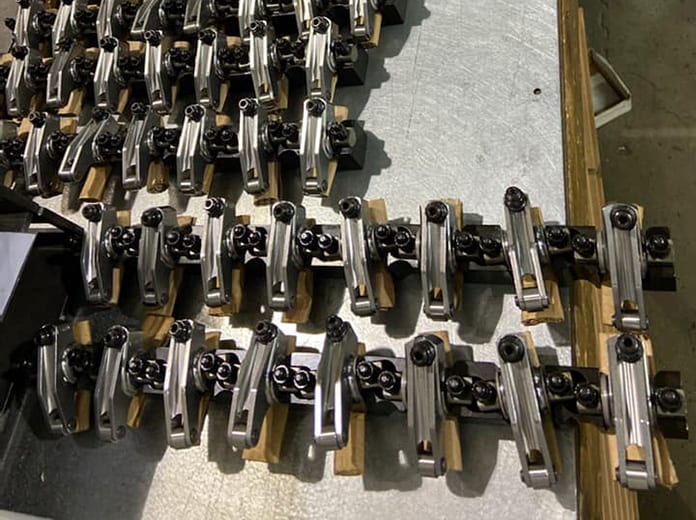
The general trend is for stronger rocker arms with less flex while at the same time always being lighter weight, which is a tall order.
Most of the employees are sympathetic because many of them race or have raced in the past. Tores doesn’t race anymore, but the company’s head engineer, Brad Rounds, competes in NHRA Super Stock Eliminator.
Besides race cars, there are some unusual vehicles that use T&D rocker arms, including Monster Trucks and offshore boats that run with multiple engines.
T&D’s customer base is split about 50-50 between the racer who does his own engine work and engine builders. The race engine builder probably gets the edge simply due to volume, as he usually orders five or six sets at a time.
“We feel our product is superior to our competition’s and we get that from the racers who switch over to us,” Elliott said. “We don’t build trick-of-the-week stuff and we don’t try to recreate the wheel. We have a proven product that is extremely well-liked.”
If he could tell potential customers one thing about T&D, what would that be?
“Our upper management cares about the end user,” Elliott said. “There are racers here that have been hands-on creating engines that make a lot of power and last longer. Our rocker arms go through a lot of R&D and testing and if they don’t work, we don’t make them.”
There is a lot of back-and-forth conversations between T&D and cylinder-head manufacturers.
“We work with them daily,” Elliott said. “They come up with a new cylinder head for an engine that they think is better and they ask us to build a rocker set for it. We get about one or two new ones a week. They want their projects turned around quickly, and we do the best we can to comply.
“Our business plan is to build the best rocker arms we can,” he continued. “Our raw material has increased in price, but usually that increase has been due to increases in shipping costs.”
For naturally aspirated racing applications, T&D recommends aluminum rockers. For street cars, boats and any other endurance-type application, it recommends steel rockers be used solely for durability.
For racing applications where blowers, turbos or lots of nitrous are used, it recommends using steel rockers on the exhaust as a minimum. For high-RPM, high-lift applications, it recommends steel rockers on both the intake and the exhausts.
What advice does T&D have for young engine builders?
“Follow instructions!” Elliott said. “Manufacturers, including us, have wonderful sets of instructions. However, there are certain people who buy $2,000 or $3,000 worth of parts and they say, ‘I know how to do this,’ and then they get them all spread out, run into problems, and then we have to talk them through it. Be patient and read the instructions, and before you start grinding things to make them fit, call us.
“T&D rocker sets are laid out using a stand height gate, which is included in every set,” he added. “Every other dimension is based off of getting the stand in the right spot. Setting rocker geometry by old-school methods nearly always results in an under-performing rocker system.”
Improper lubrication and lack of maintenance are also problems that can be avoided.
For more information, visit the company’s website at tdmach.com. The company’s 32-page catalog can be downloaded from its website and it provides a great deal of information.
A listing of some 25 dealers in the United States is also included with company names, addresses, phone numbers, websites and directions.
And like the ad on the back of the catalog says, this IS rocker science!
